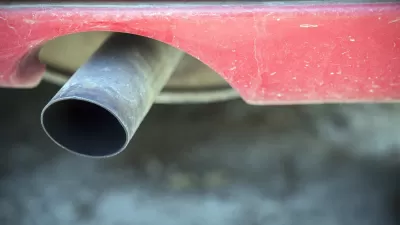As the nation's third largest oil producer, California has a long history with the oil industry, yet it's also the birthplace of the American environmental movement. Lisa Margonelli makes the case for the Golden State reducing its oil addiction.
"The history and idea of California are so tied up with oil—from the oil fields of Bakersfield and Signal Hill to millionaires like J. Paul Getty and Armand Hammer to the state’s famous car-and-freeway culture—that it is hard to imagine the state without oil," writes Lisa Margonelli, an energy policy expert, author, and former Atlantic writer. "But that is exactly what many Californians are imagining."
The comprehensive piece on Zócalo Public Square is focused somewhat on Santa Barbara, beginning with the May oil pipeline spill and the devastating 1969 offshore oil spill.
After the Exxon Valdez oil spill in 1989, national environmental groups focused their energy on reducing oil drilling in the U.S. while oil consumption and imports grew. But Santa Barbara’s independent environmental groups remained committed to “Getting Oil Out”—entirely, not just reducing oil drilling.
Interestingly, not much has changed, as noted by the recent federal legislation, "Keep it in the Ground Act." And some might question whether Santa Barbara's opposition is confined to oil or to anything harming the coast—which includes what some consider the modern day equivalent to oil derricks, offshore wind farms.
Fast forward to the passage of landmark renewable energy and energy efficiency legislation that initially included reducing oil consumption by 50 percent in 15 years. "SB 350’s radical prescription on oil use was defeated politically, without a vote, in part by the Western States Petroleum Association (WSPA)" which ran a successful campaign to convince so-called "moderate Democrats" to drop the oil reduction provision under the guise it would increase oil prices.
But outside of Sacramento, Californians just aren’t that into oil anymore: Between 2008 and 2014, the country’s highest gas prices led drivers to decrease their gas consumption by a billion gallons a year.
The trend has not continued, sadly. Even a year before gas prices plummeted in July, 2014, gas consumption began to increase.
Perhaps California's dual role as a major oil producer and environmental leader is best illustrated with none other than the driving force behind California's climate legislation, Gov. Jerry Brown. While striving to reduce oil consumption, as noted in his January inaugural speech, it was revealed by the San Francisco Chronicle on Nov. 12 that "last year (he) asked the head of California’s oil regulating agency to study the history of oil and natural gas drilling near his family’s land in Colusa County."
Hat tip: Fred Huette, Sierra Club International Climate and Energy Committee
FULL STORY: Imagining California Without Oil Refineries

Planetizen Federal Action Tracker
A weekly monitor of how Trump’s orders and actions are impacting planners and planning in America.

Map: Where Senate Republicans Want to Sell Your Public Lands
For public land advocates, the Senate Republicans’ proposal to sell millions of acres of public land in the West is “the biggest fight of their careers.”

Restaurant Patios Were a Pandemic Win — Why Were They so Hard to Keep?
Social distancing requirements and changes in travel patterns prompted cities to pilot new uses for street and sidewalk space. Then it got complicated.

Platform Pilsner: Vancouver Transit Agency Releases... a Beer?
TransLink will receive a portion of every sale of the four-pack.

Toronto Weighs Cheaper Transit, Parking Hikes for Major Events
Special event rates would take effect during large festivals, sports games and concerts to ‘discourage driving, manage congestion and free up space for transit.”

Berlin to Consider Car-Free Zone Larger Than Manhattan
The area bound by the 22-mile Ringbahn would still allow 12 uses of a private automobile per year per person, and several other exemptions.
Urban Design for Planners 1: Software Tools
This six-course series explores essential urban design concepts using open source software and equips planners with the tools they need to participate fully in the urban design process.
Planning for Universal Design
Learn the tools for implementing Universal Design in planning regulations.
Heyer Gruel & Associates PA
JM Goldson LLC
Custer County Colorado
City of Camden Redevelopment Agency
City of Astoria
Transportation Research & Education Center (TREC) at Portland State University
Camden Redevelopment Agency
City of Claremont
Municipality of Princeton (NJ)




























